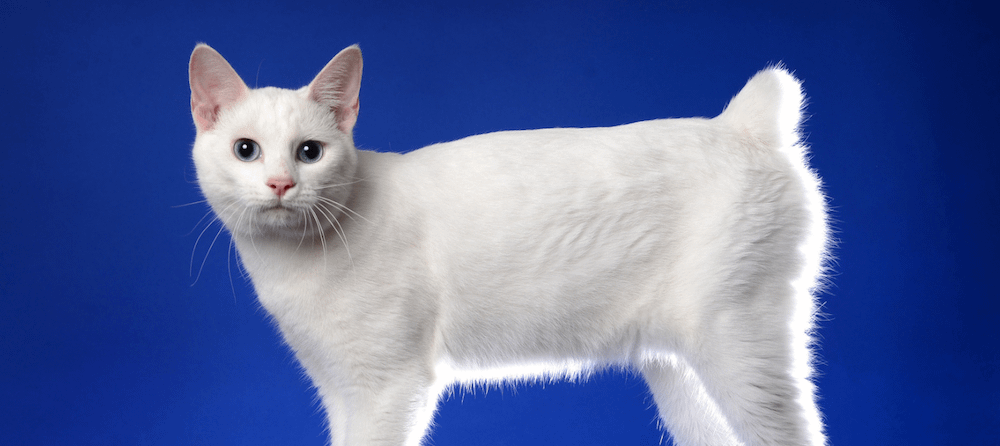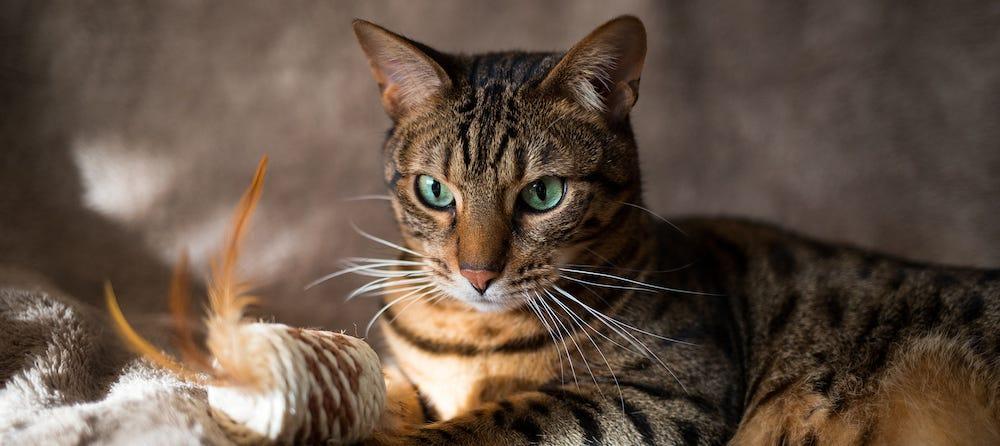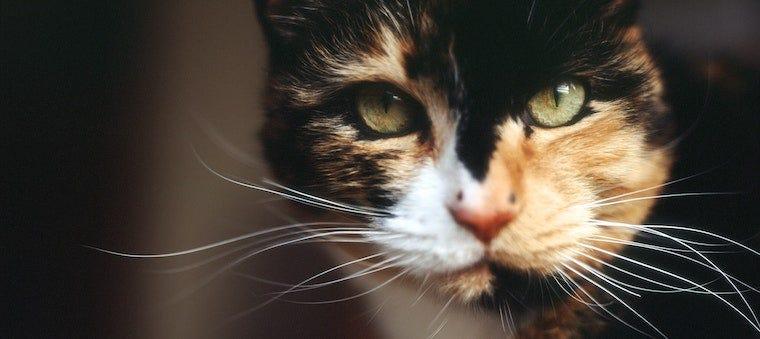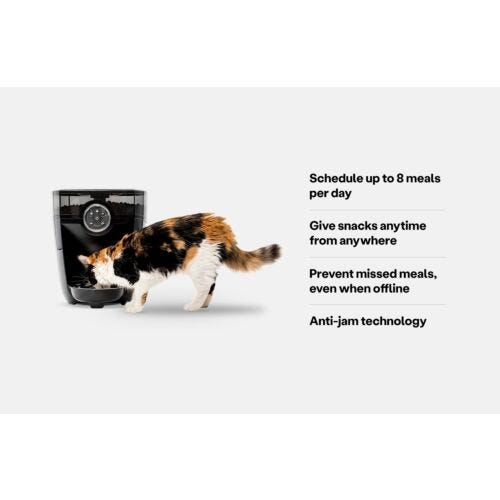The Japanese Bobtail cat is a famously adorable breed with wide eyes, a sweet disposition, and, of course, a short tail. Not only do they offer a unique and delicate beauty, they have charming personalities and make for wonderful companions.
Japanese Bobtails are sought out for their kinked tails (often called a “pom”), but they will capture your heart with their lively temperament. They are an active breed that likes to be entertained and stay playful throughout the day. The Japanese Bobtail is native to Japan but is well-loved across the globe.
| Japanese Bobtail | ...at a glance |
|---|---|
| Personality | Playful, adaptable, sociable |
| Life expectancy | 15-20 years |
| Weight | 5-10 lbs |
| Coat & colors | Short or long; various colors & patterns |
| Energy level | High |
| Affection level | High |
| Friendliness | High |
| Shedding level | Medium |
| Required grooming | Low |
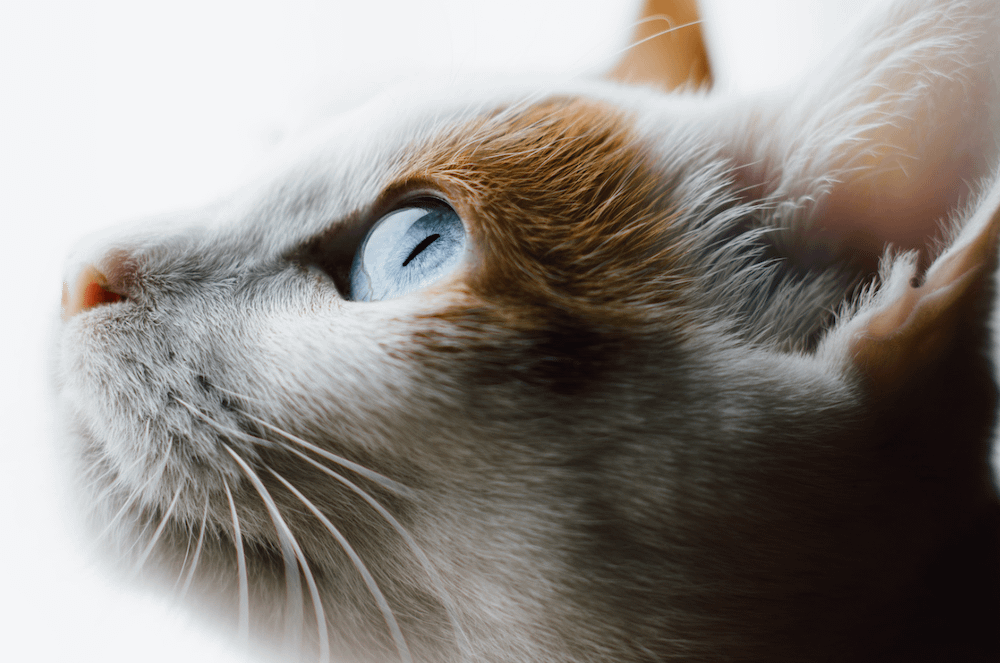
Overview of the Japanese Bobtail cat
Japanese Bobtails are small- to medium-sized cats that have a lot of energy and playfulness. They are athletic cats that are still rather short and slender, so they don’t appear very large. Though they harness a lot of strength, you might not guess that just by looking at them.
Japanese Bobtails are a sturdy breed that have a big personality. Be prepared to spend a lot of time trying to keep up with these happy felines!
Weight
Japanese Bobtails may be muscular, but they aren’t big by any means. They typically weigh between 5 and 10 pounds, and they can keep their weights healthy with minimal assistance from their humans. Some Japanese Bobtails can reach up to 12 pounds, but those are usually larger males.
Length
From the tip of their nose to the end of their tiny tails, a Japanese Bobtail can be up to 14 inches long. They are rather proportionate in their size… with the exception of their tails. The lack of a full tail on a Japanese Bobtail makes them appear smaller than they truly are.
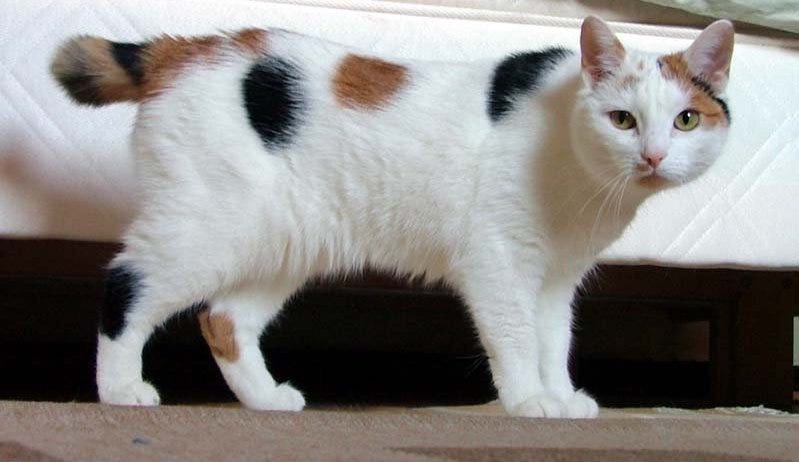
Coat
The Japanese Bobtail can have either long or short coats. The shorthair variety was granted Championship status by the CFA in 1976. The Cat Fanciers’ Association accepted the long coat variety in 1993.
Their fur is usually soft and silky without an undercoat. Ear and toe tufts are very common in long-haired Japanese Bobtails and are mighty adorable.
No color or pattern combination is preferred over another. However, many people associate predominantly white calico (Mi-Ke) patterns with Japanese Bobtails; this is largely due to their associations with the Japanese “lucky cat” figurine, Maneki Neko. (More on that below!)
In addition to white and calico, this breed can come in the following solid colors and patterns: black, red, cream, lavender, grey, sable, blue, lilac, chocolate, bicolor, tortie, and tabby.
No matter what your individual cat’s colors are, they will still be just as playful and loving as the next!
Average lifespan
Japanese Bobtails are typically healthy and hearty cats. With proper nutrition, plenty of exercise, and a safe environment, your Japanese Bobtail can live for 15 to 18 years. That is quite the lifespan!
When you adopt a Japanese Bobtail, you are surely making a commitment: Be prepared for the amount of time and energy you will put into caring for them.
History of the Japanese Bobtail
Japanese Bobtails are known as an ancient breed and can be traced back as far as the 1600s in Japan. As much as they are traceable to this time period, their creation is still a mystery.
Many stories have been told about their upbringing, including that they originated in China or Korea one thousand years ago. Some say that monks were in charge of bringing bobtail cats to Japan in order to fend off rats from their rice paper scrolls. Other sources say that a Chinese Emperor in the 6th century gifted the Emperor of Japan a pair of bobtail cats.
However, Japanese Bobtails were first recorded in the early 1600s when they were released into the streets to help maintain the rat population that was infiltrating silkworm farms. These rodents were threatening the silk trade in Japan.
At this point, the breed became illegal to own as pets because they were needed to maintain the rodent populations. As a result, they become known as “street cats.” To this day, spotting a Japanese Bobtail on the streets of Japan is common.
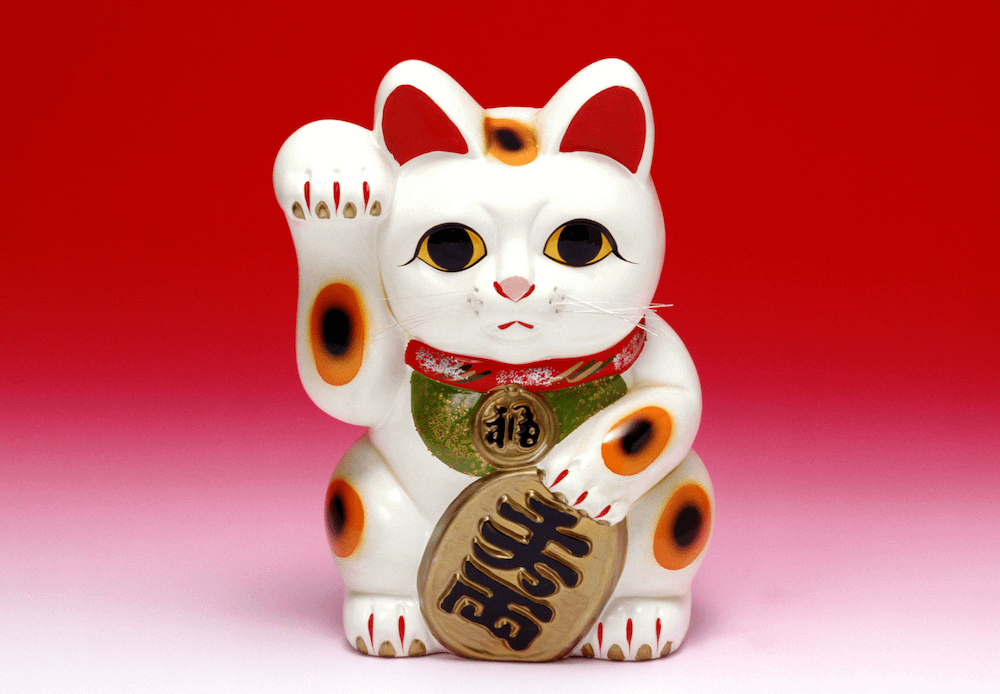
Maneki Neko
Another place you’ll likely spot a Japanese Bobtail? Lined along the shop windows in Chinatown, perched next to the cash register of your favorite Asian restaurant, and more in the form of a statue called Maneki Neko. The figurine is believed to bring good luck to its owner. “Maneki-neko” translates to “beckoning cat” or “invitation cat,” waving in good fortune to those who keep it.
Japanese Bobtail cat characteristics
Japanese Bobtails are quite petite but still athletic. They are playful, outgoing companions that sport an adorable look. They are easily recognizable with their clean lines, lean bodies, and tiny tails. Interestingly, their hind legs are longer than their front legs.
This cat’s face really stands out with large, oval eyes, high cheekbones, and a long nose that is distinctive to other breeds originating from certain areas across East Asia. The ears are wide-set and positioned at right angles to the head. The head is famously shaped like an equilateral triangle. These cats can be odd-eyed, which means they have two different eye colors, but two blue eyes is also acceptable.

Short bunny tails
Their tails are formed due to a harmless and natural genetic mutation, and they resemble that of a bunny tail: short and tufted. A Japanese Bobtail’s tailbone is no longer than three inches from the body and should be clearly visible, according to the breed standard. Their tails can be rigid or flexible, but they are usually proportionate to the rest of their bodies.
No two tails are alike. They might vary in size, tufts, kinks, and curls, so you shouldn’t expect them to look any certain way. It’s one of their most defining features, and even so, each Japanese Bobtail you come across will have slightly different tail types.
Personality and behavior
Japanese Bobtails are extraordinarily social and happy cats. They are adaptable and can make themselves comfortable in most spaces. They love sharing their space with other animals and would benefit from having a feline companion. They also do really well with dogs as long as they are introduced respectfully.
This cat breed is known to rely on their humans and likes to spend as much time as possible with them. Your Japanese Bobtail will follow you, interrupt your business, and chirp at you when they are looking for attention or just want to seem agreeable.
If you are looking for a sidekick, the Japanese Bobtail would graciously accept the position.
Exercise and play
Japanese Bobtails are intelligent and love to learn new ways to interact with their humans. They like puzzles, playing fetch, chasing lasers, and learning tricks. This breed is even a fan of competing in cat shows.
They are athletic and energetic, but they love to wind down with their favorite humans each night, transitioning from running laps around the kitchen to a snuggly lap cat.
This breed is known to be strong for their size and needs proper exercise to maintain good health. Luckily, because these cats are so active, they tend to have an easy time staying healthy without much help from you.
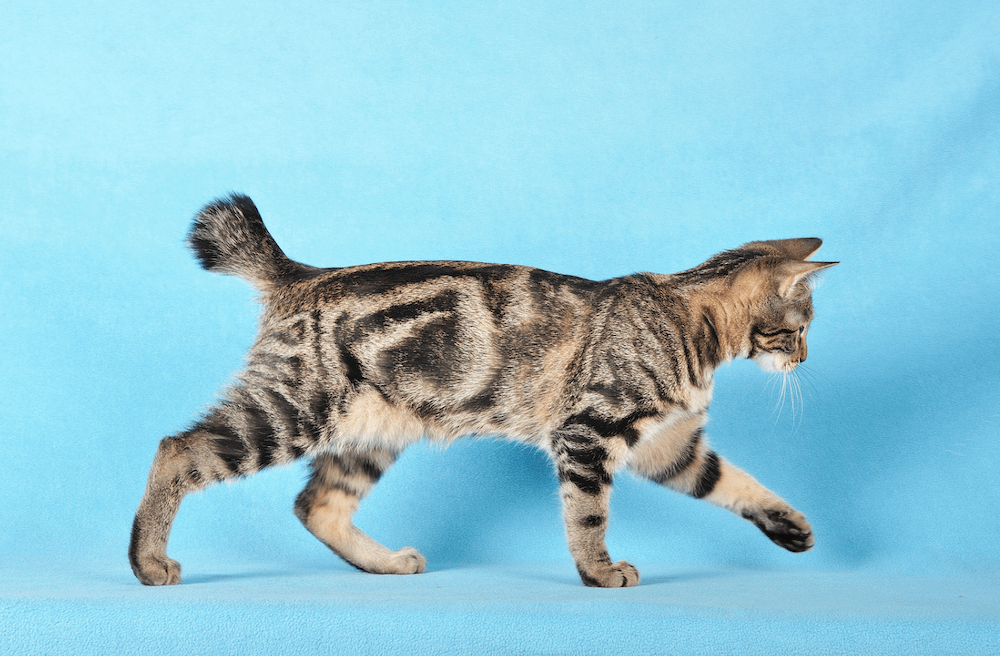
Caring for a Japanese Bobtail cat
Taking care of a Japanese Bobtail is pretty straightforward. You won’t have to worry about getting your Japanese Bobtail up and playing; they’ll burn plenty of calories on their own, so they’ll need regular feedings and a healthy diet.
Ensure their bathroom space is clean (easy with the help of a self-cleaning litter box like Litter-Robot—and you never have to scoop the litter box again!).
Grooming
Although Japanese Bobtails shed, they don’t shed as much as some other cats because they don’t have an undercoat. Grooming them once a week is likely enough to prevent matting, even though matting is unlikely. This should keep their coats shiny and healthy by removing dead hairs.
Trimming their nails regularly will help limit discomfort (and scratched-up furniture), and keeping their teeth clean will help lower their risk of periodontal disease.
Possible health problems
Japanese Bobtails aren’t particularly prone to genetic diseases. They are relatively healthy and can live a long life if they are properly cared for. However, like all domestic cats, they are prone to obesity if overfed. Balanced, well-regulated meals are needed to help keep their weight at the suggested breed standard.
Loving a Japanese Bobtail
Adopting a Japanese Bobtail means that you will have a new best friend roaming the house. They will be your go-to on a bad day, the first to greet you when you walk in, and a source of warmth and comfort on cold nights. Your friends and family will be excited every time they come to visit because your kitty will be there, ready to entertain.
Prepare yourself for their spunk and spark by purchasing cat furniture like scratching posts, shelves for perching, and plenty of interactive toys. Your Japanese Bobtail will thank you for keeping them so occupied and return the favor with lots of love.
Sources:
- Japanese Bobtail - Students | Britannica Kids
- Periodontal Disease In Cats: Back To Basics--With An Eye On The Future | NCBI
Photo credits:
- © Jonik / CC-BY-SA-2.0
- © Heikki Siltala / CC-BY-SA-3.0
